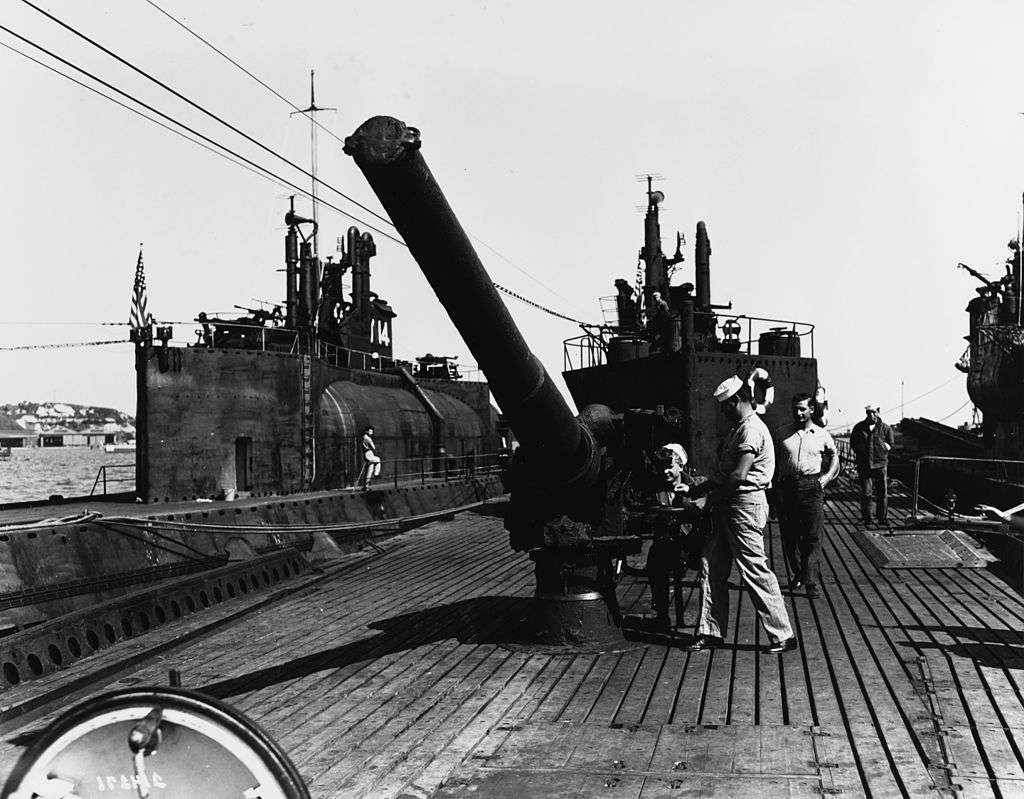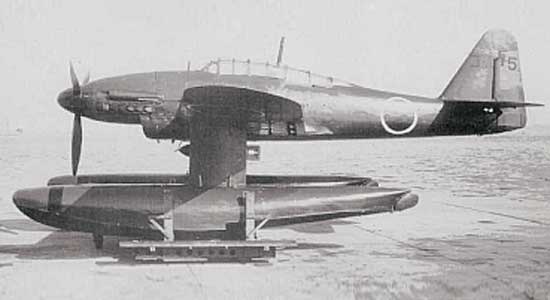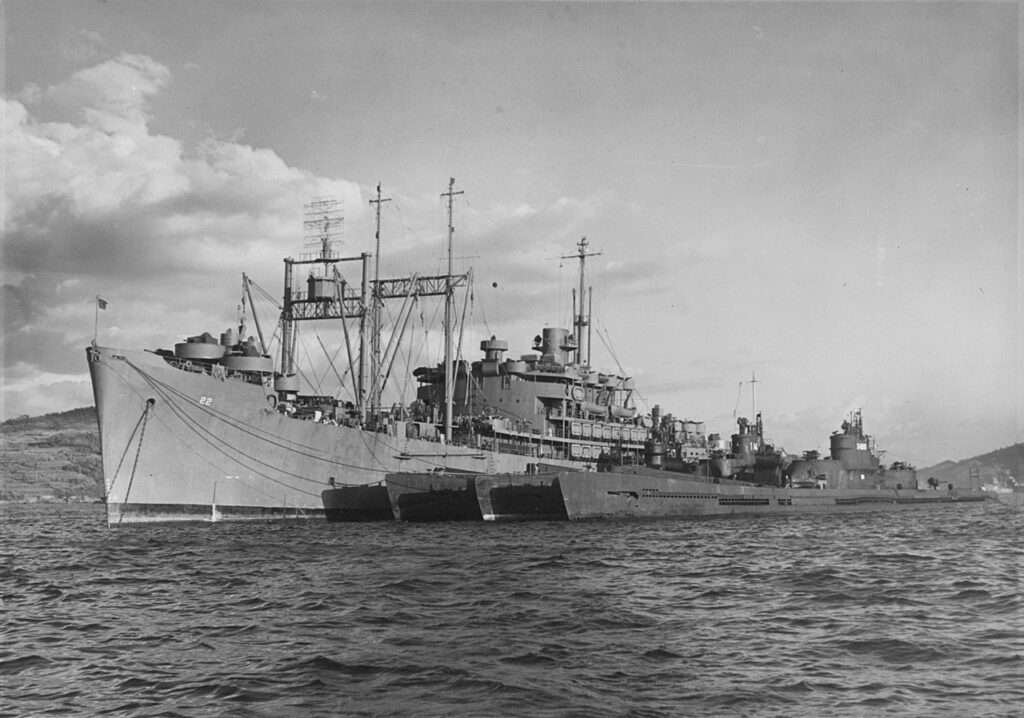The I-400 class, comprising three submarines – I-400, I-401, and I-402 – represented a leap forward in naval engineering, incorporating advanced features that pushed the boundaries of submarine warfare.
With their immense size, long-range capabilities, and ability to launch aircraft, these submarines were designed to strike fear into the hearts of their adversaries and redefine the possibilities of naval combat.
Origins of the I-400
The I-400 Class of submarine was the brainchild of Japanese Admiral Yamamoto. He wanted a submarine aircraft carrier with unlimited range that would be able to strike the American mainland.
 I-400 submarine after US capture.
I-400 submarine after US capture.
Yamamoto’s idea was nothing new. The United States, Germany and even Japan had played with the idea before.
He submitted his proposal on January 13, 1942. The initial proposal saw 18 of these giants to be built, all capable of holding multiple aircraft.
Just over a year later, the Imperial Japanese Navy began work on developing, what they called, the Sen Toku type submarine.
The I-400’s Design
The I-400 Class was a machine of monstrous proportions. They were 400 feet long and 39 feet wide. It made them the largest submarines of The Second World War and their dimensions would only be beaten by submarines developed in the 1960s.
The submarine had a watertight aircraft hangar on the top deck. The hangar was just over 100 feet long and 11 feet wide.
 The hangar door of an I-400 Class submarine. The door was made watertight by a 2 inch rubber gasket.
The hangar door of an I-400 Class submarine. The door was made watertight by a 2 inch rubber gasket.
For armament, a 14 cm deck gun was fitted just behind the hangar, along with three 25 mm anti-aircraft guns which were located above the hangar.
 The 14 cm gun on board an I-400 Class submarine.
The 14 cm gun on board an I-400 Class submarine.
There were also eight torpedo tubes mounted in the bow of the vessel.
The main armament of the I-400 Class came in the form of the three Aichi M6A1 Seiran floatplanes. The aircraft’s wings, vertical and horizontal stabilizers could be folded in order to make the plane fit into the hangar.
The plane’s floats would be fitted just before take-off. The aircraft would then be propelled from the deck by a compressed air catapult system.
The Seiran had a modest pay-load, able to carry one 1,800 lb bomb.
 The Aichi M6A1 Seiran Floatplane.
The Aichi M6A1 Seiran Floatplane.
In April 1943, Admiral Yamamoto, who was the main pusher for the project, was killed. From here, support for the project dwindled and the order for eighteen I-400s changed to five.
The first vessel of the I-400 Class, known as I-400, was put into service in December 1944. The second, named I-401, joined the fleet in January 1945. Lastly, the third submarine, I-402, was commissioned in July 1945.
By the time of the third I-400 Class being commissioned, Japan was heavily on the back foot. Thoughts of bombing the American mainland, especially with such little numbers, now seemed crazy.
This, coupled with war time resource shortages, put a stop to any more submarines in the I-400 Class being built.
Service History Of The I-400 Class
In early 1945, there were plans drawn up for the I-400 and I-401 to launch an attack against the lock gates on the Panama Canal. The plans were for the subs to release their aircraft near the Canal, which the planes would then bomb.
Around April, 1945, the plans were changed for the pilots to use kamikaze ramming tactics on the lock gates instead of bombing them.
Training for the mission commenced. Massive wooden full-scale models of the gates were built and the pilots prepared for the attack.
The attack on the Panama Canal was halted after Okinawa fell. The Japanese believed that striking the Canal was futile due to the bulk of the American fleet already being present in the Pacific.
 An image giving a great view of the deck and hangar door
An image giving a great view of the deck and hangar door
The next plan was for the I-400 and the I-401 to attack a concentration of fifteen American aircraft carriers based at Ulithi Atoll. Again, the Seiran aircraft would use kamikaze tactics.
This plan would also not go ahead, this time being stopped by the Japanese surrender on August 15, 1945.
Consequently, I-400 and I-401 were ordered to surrender themselves to American forces.
Was the I-400 Aircraft Carrier Submarine Successful?
The I-400 Air Craft Carrier Submarine had bittersweet success story. Despite being the largest of submarines during WWII, it would not see combat. Every plan to use it was either cancelled or thwarted.
In the end, the I-400 class submarines were still marvels of navel engineering. Their development led to breakthroughs in the field.
Remains Of The I-400 Class
After the surrender of Japan, the Americans received a message from the Soviet Union that they wanted one of the I-400 subs to inspect.
In response to this, the Americans sank the I-402, and took the I-400 and I-401 to Pearl Harbor.
 The I-401, I-14 and I-400 submarines after surrendering to US forces.
The I-401, I-14 and I-400 submarines after surrendering to US forces.
After Navy technicians concluded their inspections of the two remaining subs, they were scuttled off the Coast of Hawaii.
The wreck locations of all three I-400 Class submarines were kept a secret to prevent the Soviet Union from finding them and utilizing their technology.
However, the wrecks have since been located. I-401 was discovered in 2005, I-400 in 2013, and I-402 was found in 2015.
Cherry Blossoms At Night
One part of the I-400s story that must be mentioned is the planned operation to use the subs to hit the United States with chemical weapons.
Dubbed ‘Operation Cherry Blossoms At Night’, the I-400 submarines were to launch their planes near the California Coast.
The aircraft would release bombs filled with infected fleas with desired hope to infect the human population of California.
 The I-402 after capture.
The I-402 after capture.
The plan was scheduled for September, 1945 – one month after the Japanese surrender.
Conclusion
The I-400 class submarine was an extraordinary achievement in naval engineering, symbolizing Japan’s quest for technological supremacy during World War II.
While their operational impact was limited, the I-400 class submarines left a massive mark on naval history and their design and capabilities inspired future generations of submarines, influencing the development of modern naval vessels.